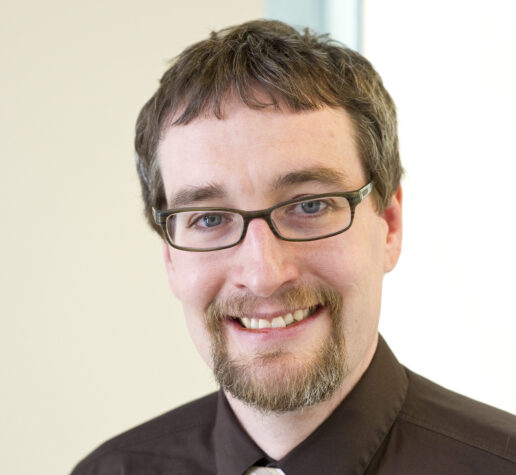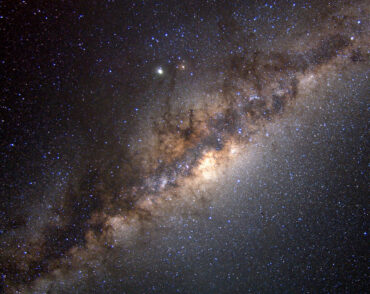
3Q: Scott Hughes on cosmic distances and the future of gravitational wave astronomy
Professor of physics describes our understanding of the expansion of the universe through “standard sirens.”
On Monday, Oct. 16, 2017, National Science Foundation Director France Córdova, MIT senior research scientist and LIGO Scientific Collaboration spokesperson David Shoemaker, and other representatives from Caltech and the Virgo detector, announced the detection of GW170817 — the merger of two neutron stars as observed by the two Laser Interferometer Gravitational-wave Observatory (LIGO) detectors, located in Livingston, Louisiana, and Hanford, Washington.
Unlike the four binary black hole systems previously detected, the observation of a neutron-neutron star merger opens up a new chapter in the science of gravitational waves: the first correlation between gravitational waves (GWs) and an electromagnetic signal, in this case short-hard gamma ray bursts (SHBs).
In research preceding the LIGO detector systems’ first and second observing runs, Scott Hughes, MIT professor in the Department of Physics, working with Daniel Holz of the University of Chicago, developed a theoretical technique by which measuring the gravitational waves and SHBs of this kind of binary system could be used to measure cosmic distances, and to learn about the universe’s expansion.
Hughes, who is not a member of the LIGO collaboration, answers questions about this technique and the future of gravitational wave astronomy.
Q: What are “standard candles” in astronomy and how does the “standard siren” technique allow us to measure cosmic distances with greater certainty than other methods?
A: Measuring distances is one of the hardest problems in astronomy. What kind of yardstick can we use to measure distances so large that light takes millions or billions of years to travel across?
Imagine a gigantic lightbulb that puts out 400 trillion trillion watts — that’s the luminosity of our sun. The energy we receive from this lightbulb falls off as the distance squared between us and the bulb. Such a lightbulb 2 light years away would be four times dimmer than if it were 1 light year away. This source is a standard candle: an astronomical object whose luminosity is known so well that we can infer how far away it is from the brightness we measure.
Although nature doesn’t provide us with such standard lightbulbs, astronomers have found that certain objects have luminosities that can be calibrated so that they are effectively standardized. Key to standardizing these objects are a series of measurements called the “cosmic distance ladder.” This uses a technique called parallax, which examines how the relative position of nearby stars on the sky changes as the Earth moves in its orbit. Using parallax, astronomers have learned that a class of stars called Cepheid variables — thousands of times more luminous than our sun — are very good standard candles. They can find these candles in distant galaxies, and use them to determine how far away those galaxies are.
In 1986, Bernard Schutz of the University of Cardiff in Wales pointed out that binary coalescence — such as the merger of two neutron stars — is a self calibrating standard candle: Measuring its waves makes it possible to directly measure the binary’s distance without the cosmic distance ladder. Schutz’s key observation is that the rate at which the binary’s frequency changes is directly related to the system’s intrinsic gravitational wave “loudness.” (Gravitational waves have a sound-like character — recall the famous “chirp” from the first detection — and it is useful to think of strong events as loud, and weak events as quiet.)
Just as the observed brightness of a star depends on both its intrinsic luminosity and how far away it is, the strength of the gravitational waves that we measure depends on both their source’s intrinsic loudness and how far away it is. By observing the waves with detectors like LIGO and Virgo, we learn both the waves’ intrinsic loudness as well as their loudness at the Earth. This allows us to directly determine distance to the source.
About 12 years ago, Daniel Holz and I examined how well this idea could be implemented, focusing on how it could be done if the gravitational waves were accompanied by some electromagnetic signature, such as a short-hard gamma-ray burst. Given the sound-like character of gravitational waves, we named such an event a “standard siren.” Our analysis got us excited about how the self-calibrating nature of these events could make them powerful tools for important measurements in cosmology.
Q: How does this observation provide a probe of the universe’s expansion and what could other potential observations — such as a black hole-neutron star merger — tell us about the origin of black holes or the expansion of our universe?
A: Edwin Hubble first observed that our universe is expanding, finding that distant galaxies move away from us at a rate proportional to their distance. The wavelengths of light from such galaxies are shifted to the red part of the spectrum, a phenomenon in light akin to the Doppler effect in sound. Precise measurements of distance and redshift are needed in order to figure out how fast the expansion is proceeding. The binary inspiral of GW170817 measured its distance; telescope observations of the accompanying gamma-ray burst measured its redshift. Those are exactly the pieces of information needed to measure Hubble’s constant, which tells us how fast the universe is now expanding.
Any measurement of binary coalescence that is accompanied by an electromagnetic event, like a gamma-ray burst, can be used to measure the expansion of the universe exactly as was done with GW170817. Indeed, we hope for more events like this: Combining many distance-redshift measurements will make it possible to average out noise and other error effects, and improve our ability to measure Hubble’s constant.
Although Hubble’s constant had already been measured by a few different techniques, these techniques appear to be converging to two different values! It is unclear if this discrepancy is because of some currently unknown bit of cosmic physics, or if it is a systematic error in the measurements. Because the standard siren does not require a series of calibrations, it has tremendous promise for resolving this tension in the Hubble constant’s value.
In addition to telling us about the distance to the event, each of these measurements such as GW170817 provides a wealth of data about the masses and other properties of the objects involved. As we build up a catalog of data about things like black hole masses and spins and neutron star masses, we will gain more and deeper understanding of how these objects are distributed in the universe, shedding light on the nature of the matter that makes up neutron stars and how some of the heaviest elements were formed.
Q: What might space-based gravitational wave and electromagnetic measurements tell us that ground-based measurements from LIGO or Virgo could not?
A: This question is near to my heart, since I have spent a lot of my career thinking about measurements using the Laser Interferometer Space Antenna (LISA) — the planned space-based gravitational-wave detector. Indeed, the primary focus of my first standard sirens paper with Holz was on sirens enabled by LISA measurements!
LISA will be sensitive to gravitational waves at much lower frequencies than LIGO and Virgo can measure. Low-frequency waves come from much more massive sources, like the coalescence of black holes millions of times more massive than the sun. Such sources may enable LISA to make standard siren measurements from sources that are tremendously far away — perhaps tens of billions of light years, from an epoch when the universe was relatively young.
The distant standard sirens that LISA may enable tell us about the expansion of the universe at a very different cosmic time than the relatively nearby sirens (a few hundred million light years away) that LIGO and Virgo measure. Together, these events would make it possible to precisely probe the expansion of the universe over a wide range of cosmic times, enabling a wholly new way of probing the large-scale geometry of our universe.


